
Geographical location of Central Veracruz where the area of Cerro de las Mesas is highlighted
Title: Ruta De La Obsidiana
Country: Mexico
Location: Cerro De Las Mesas / Paso Del Bote, Mpio. Tlalixcoyan (Ver., México)
Abstract: Ruta de la Obsidiana is an international and interdisciplinary research project on the dynamics of change of Mesoamerican indigenous cultures, with specific reference to the transition from the Olmec to the post-Olmec phase.
Brief presentation of the project
Institutions:
The project is directed by the Centro Studi Americanistici “Circolo Amerinidano” onlus (CSACA) in collaboration with the following institutions (in alphabetical order):
• Humanities Department of the University of Salerno.
• Institute of Anthropological Research, National Autonomous University of Mexico (UNAM), CDMX (Mexico);
Members of the project:
The project is divided into 5 sub-projects (SP). The researchers responsible for the elaboration and direction of the sub-projects are:
• Dr. Romolo Santoni, president of the Centro Studi Americanistici “Circolo Amerinidano”; general director of the project and director of sub-project 1;
• Dott.ssa Larissa Terranova (Centro Studi Americanistici “Circolo Amerindiano”), collaborating of sub-project 1;
• Dr. Aura Fossati (Centro Studi Americanistici “Circolo Amerinidano”) co-director of sub-project 2;
• Dr. Luis Alberto Barba Pigarrón ((Instituto de Investigaciones Antropológicas of the UNAM of Mexico), co-director of sub-project 2;
• Dott. Jorge Blancas Vázquez (Instituto de Investigaciones Antropológicas de la UNAM), collaborating of sub-project 2;
• Dott. Agustín Ortiz Butrón, (Instituto de Investigaciones Antropológicas of the UNAM), collaborating of sub-project 2;
• Dr. Mattia Petrini (Centro Studi Americanistici “Circolo Amerinidano”) collaborating of sub-project 2;
• Prof. Rosa Maria Grillo (Department of Humanities, University of Salerno, Italy / Centro Studi Americanistici “Circolo Amerinidano”), coordinator of sub-project 3;
• Dr. Giulia Nuzzo (Dept. of Humanities, University of Salerno, Italy / Centro Studi Americanistici “Circolo Amerinidano”), collaborator of sub-project 3;
• Dr. Elsa López (Centro Studi Americanistici “Circolo Amerinidano”) director of sub-project 4;
• Dott.ssa Thea Rossi, (Università degli Studi di Chieti / Centro Studi Americanistici “Circolo Amerindiano”), co-director of sub-project 4;
• Dr. Maria Luisa De Filippo, (Centro Studi Americanistici “Circolo Amerinidano”) coordinator of the cooperation for the development sub-projects.
Having divided the General Project into 5 sub-projects, plus the cooperation for the development sub-project. Each member’s functions are stated in each of the sub-projects.
History:
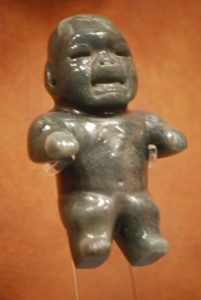
Niño de Cerro de las MesaS
The interdisciplinary project presented below has a long working experience. In fact, it was born from a seminar organized by CSACA in Bastia Umbra (Perugia), which lasted interruptedly from 1983 until 1988. Its object of study was the disintegration mechanisms of the Olmec hegemony in pre-Columbian Mesoamerica, especially through the analysis of the iconographic-symbolic material.
The seminar was named Ruta de la Obsidiana, for the role that the route of this stone’s trade had in the historical-political evolution of Mesoamerica between Olmec and Post-Olmec cultures.
A new project began in 1993 (named after the seminar), as Kauffman’s and Justeson’s studies on the Mojarra Stela 1 were being published and, in consideration of the obvious similarities between the conclusions of the seminar and some results of the research made on the Stela 1, as well as the research prospects that the latter presented (and taking into account these similarities). Ruta de la Obsidiana, as a project, started working between the years 1994 and 1998.
The first of these missions, in 1994, with the visit to Cerro de las Mesas, turned the whole project upside down, both in terms of the surface archaeological framework and the "discovery" of the existence of an ejido within the archaeological site. This generated a profound change from a simple objective of study to one that would consider first the social context and that each activity would be oriented in favor of that contex
The conclusions of this first phase of the project were exposed In the article by Milena Cattaneo, 1998, Ruta de la Obsidiana 1994-1998: fra egemonia olmecatl ed avvento di Teotihuacan, l'importanza della cultura di Cerro de las Mesas, pp. 295-302 in "Thule. Rivista italiana di studi americanistici", no. 4/5, Argo Editrice, Lecce, in itinere in the article Eredità olmeca, published by the magazine “Archeologia viva” n. 60, November / December 1996, and, definitively, in the article Olmecography: the Olmec historical-cultural definition through the iconographic-symbolic heritage, published in n. 4/5 of “Thule. Rivista italiana di studi americanistici, April / October 1998.
For the first time, in these publications, there was an official mention of a culture of Cerro de las Mesas, different from what was until then was known by this name (belonging to the first part of the Classic era), indicating the homonymous site as a central part to the flowering of this culture.
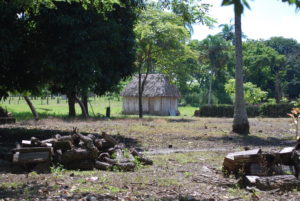
Paso del Bote, Tlalixcoyan, Veracruz, México
The 1994/1998 work phase was carried out through five study missions in Mesoamerica, various study seminars and a permanent laboratory activity, both in Italy and in Mesoamerica. The conclusions were presented during various participations at the International Congress of American Studies, in Italy and Mexico, presented through publications and public conferences.
The set of hypotheses formulated by the research group has opened up specific study perspectives, again in the context of the symbolism and iconography of the Olmec / post-Olmec phase, as was exposed in the article Olmecography: the historical-cultural definition of the Olmec through the iconographic-symbolic heritage, and later ratified in a session organized especially on this theme in the XXIII International Congress of American Studies (Perugia, 4-5-6 May 2001). Precisely, this latest event offered the opportunity to broaden the debate between scholars of different lines of research and different institutions that participated to the Congress.
From this debate:
• it emerged that some hypotheses and observations led to the reflection on particular articulations of cultural evolution at a pan-Mesoamerican level;
• the need arose to broaden research to other types of disciplinary approaches and chronological spheres.
In order to be able to bring out certain mechanisms underlying the cultural changes in Mesoamerica, by navigating through the different pre and post-Colombian phases, consistent with the purest tradition of American studies, an interdisciplinary approach was taken. Since it was paramount to make research in the interactive coexistence of multiple approaches, in the identification of constants of characters of the symbolic world (in the first place, but not only) along the entire diachronic development.
So the project that was initially proposed for a second period of investigation (2000-2004). During the second half of 2001, it took the form of a larger project, containing not only more lines of investigation and disciplinary perspectives, but also of sub-projects, where there would be the same continuity of study of the Olmec / post-Olmec iconographic-symbolic heritage in the Isthmus area, which had provided the traditional basis of the 1994/1998 phase.
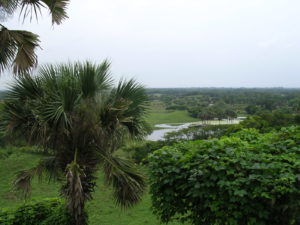
Cerro de las Mesas seen from the major pyramid
Thus, 7 lines of research were established and developed between 2001 and 2016, in collaboration with various researchers and different institutes.
Sub-project developed between 2001 and 2016:
The following sub-projects were developed:
• Analysis of iconographic-symbolic materials in the isthmic area between the 5th and 1st centuries before our era: sub-project continuation of the original project with an anthropological-symbolic profile and ethno-historic perspective, dedicated to the symbolism and iconography of the Olmec / post-Olmec period and the culture of Cerro de Las Mesas, under the direction of Romolo Santoni and based in the Centro Studi Americanistici “Circolo Amerinidano” in Perugia, Italy;
• Cerro de las Mesas and its regional context, Veracruz Mexico: a sub-project closely related to the previous one, consisting of an archaeological study to be carried out in the same site of Cerro de las Mesas; directed by the archaeologist Francesco Pacelli and the anthropologist Romolo Santoni (2008), Giovanna Battaglini (2009/2010) and Aura Fossati (2011 until today) and based in the Centro Studi Americanistici “Circolo Amerinidano”, in Perugia, Italy;
• Olmec universe and ancient cultures of Mesoamerica: the theme of this sub-project referred to an intent of comparative interpretation of Mayan phonetic writing and Olmec iconography linked with the retrospective reconstruction of ideological-religious concepts; this sub-project was directed by prof. Galina Hershova, with its main base at the Moscow Academy of Sciences, Russia;
• Tradition, innovation and circulation in Mesoamerica: the research field of this sub-project was, in general, the complex relationship between the different “major” Mesoamerican cultures and, also, between these and the western-Hispanic super-layer in the process of global horizontal influence and the reaction to the vertical influence which produces a remodelling of traditions which incorporates and re-elaborates contributions from outside; this general approach applies substantially to three areas: representation, language and literature; Prof. Antonio Melis was in charge, coordinating a group of the CISAI of the University of Siena (Italy), where this sub-project was based;
• Cultural heritage and social transformations between the Mixe-Zoques of the Isthmus of Tehuantepec: this sub-project aimed to explore the cultural roots of the Mixe-Zoques, with particular attention to the elements of continuity between the current symbolic imagery and that of the pre-Columbians periods and how their oral traditions and ethno-history fit into the linguistic and archaeological reconstruction of the cultural evolution of the Isthmus; directed by the anthropologist Menno Oostra Ph.D., based at the LASO, Fundación de Investigación Social y Económica de América Latina, Amsterdam, Holland.
• Health dynamics between hegemony tradition and modernity in the popoluca area (later called: Symbolic universes of reference of the concepts of health and infirmity among the Popoluca of the South of Veracruz, México): this sub-project, dedicated to the symbolic world linked to contemporary medicine of the Southern Gulf area, in connection with the use of elements of pre-Columbian origin, was carried out in collaboration with the Angelo Celli Foundation for a culture of health and directed by Prof. Tullio Seppilli.
• Presence of the indigenous tradition of the Mesoamerican isthmic zone in the literature of the 1900s: starting from the observation of the rebirth of attention towards the indigenous world and its traditions, this sub-project aimed to highlight and analyse the presence of symbols, rituals, iconography , mythology, lexicon, syntax and any cultural expression attributable to the indigenous world, both pre-Columbian and current, with particular reference to the Gulf Region and to the Totonaca, Popoluca, Mixe and Zoque ethnic groups in the Mesoamerican literary reality of the 1900s. The sub-project was directed by Prof. Rosa Maria Grillo of the University of Salerno.
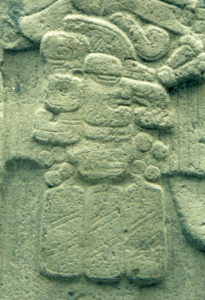
In the iconography that can be reassembled at this time, throughout the isthmic area, a character is repeated obsessively, in profile with feline, ophiomorphic and ornithomorphic characters, which in the project we called GWLN (God With Long Nose)
This complex articulation works only partially and as of 2007 enters a transitional phase in which mainly SP 1, 2 and 6 work. Highlights of this period are surely the archaeological mission of November/December 2009 directed by Giovanna Battaglini (of the University of Perugia) with the codirection of Aura Fossati (CSACA) and the participation of the members of the archaeological enterprise of Intrageo and Paolo (Soprintendenza Archeologica Belle Arti e Paesaggio of Siena, Grosseto and Arezzo) and of the cooperation SPs (2010/12 and 2012/15) financed by Tavola Valdese (www.amerindiano.org/cooperazione/). The archaeological mission will carry out an accurate topographic survey that will specify the one already carried out by Barbra Stark.
Current phase, starting in 2018:
The project undergoes an important restructuring during 2017. The disappearance of some collaborations and the economic difficulties impose the downsizing of the project. But above all, the need to tighten on lines of research strictly consistent with the general perspective of the project, suggest to orient the observation on 6 lines
• Analysis of iconographic-symbolic materials in the isthmic area between the 5th and 1st centuries before our era: sub-project continuation of the original project with an anthropological-symbolic profile and ethno-historical perspective, dedicated to the symbolism and iconography of the Olmec / post-Olmec period and the culture of Cerro de Las Mesas, under the direction of Romolo Santoni (Centro Studi Americanistici “Circolo Amerinidano”);
• Cerro de las Mesas and its regional context, Veracruz Mexico: a sub-project closely related to the previous one, it consists of an archaeological study to be carried out in the same site of Cerro de las Mesas; directed by the archaeologist Aura Fossati (Centro Studi Americanistici “Circolo Amerinidano”) and the geophysical archaeologist Luis Alberto Barba Pigarrón (Instituto de Investigación Antropológicas de la UNAM);
• Presence of the indigenous tradition of the Mesoamerican isthmic zone in 20th century literature: continuation and same title of the previous SP 7, it claims to highlight and analyse the presence of symbols, rituals, iconography, mythology, lexicon, syntax and any cultural expression attributable to the indigenous world, both pre-Columbian and present, with particular reference to the Gulf Region and to the Totonaca, Popoluca, Mixe and Zoque ethnic groups in the Mesoamerican literary reality of the 1900s; the sub-project is directed by Prof. Rosa Maria Grillo (Università di Salerno /Centro Studi Americanistici “Circolo Amerindiano”);
• Economic and social organization in Paso del Bote: sub-project aimed at identifying the socio-economic basic elements through interviews, demographic and economic surveys, historical-documentary research, the contemporary reality of the settlement of Paso del Bote and its history; propaedeutic of sub-project 6; directed by Dr. Elsa López (Centro Studi Americanistici “Circolo Amerinidano”);
• Development in Paso del Bote: finally, the SP dedicated to the implementation of intervention plans with the dual prospect of safeguarding cultural heritage and promoting cultural, social and economic progress of the population residing in Paso del Bote, which is located within the archaeological site of Cerro de las Mesas; directed by Dr. Maria Luisa De Filippo (Centro Studi Americanistici “Circolo Amerindiano”.
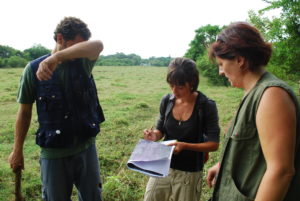
Mission 2009: Federico Spiganti, Aura Fossati and Giovanna Battaglini
Object of the research:
The space where the contribution of the various scientific abilities would be more profitable is therefore that of the different forms of transformation, which start from the transition from Olmec to post-Olmec Mesoamerica, with the aim of providing a contribution to the clarification, not only of what was one of the main moments of the cultural change in this area, but also of some contemporary outcomes in terms of the ethnic and linguistic structure of Mesoamerica itself, towards which our observation will extend.
In contrast to a certain tendency of American studies to favour the elements of persistence of indigenous cultures, with the constant risk of “folklorizing” them and, in some way, “museificating” them, our project, instead, intends to focus on the dynamics of change and of adaptation that form the core of their own vitality.

Cerro de las Mesas,Gran Plaza
This, also, in the case of specific moments of our study, directed precisely to those symbolic forms of the contemporary Mesoamerican world, which in some way are placed on the same evolutionary filum that belong to the pre-Columbian period. We will therefore analyse these dynamics by opening spaces on a plurality of layers, from the symbology to that of contemporary rituals, from material culture to therapeutic practices.
Methodology:
The reference area, therefore, consists of the objective of making a contribution to the clarification of certain mechanisms and dynamics of cultural change in Mesoamerica, starting from the observation of one of the key moments of the historical-cultural evolution of this area.
From this more general context, various lines of investigation are derived, each connected to certain disciplinary perspectives, their own methodologies and specific objects that will have to be defined and explained in itinere.
Based on the specified objective set out above and the interests expressed by the various researchers, different sectors or lines of investigation have been identified at the moment, from cultural anthropology to archaeology, from sociology to medical anthropology.
In the context of the investigation thus outlined, individual sub-projects were developed –other might be created- by various researchers or groups of researchers, members of this project, where the interaction between these will be constant and of high degree, although many spatial and temporal contaminations and interpenetrations might occur.
The individual sub-projects can thus be carried out within a fully interdisciplinary activity between the different lines of investigation and the materials produced will organically constitute the whole of the research results.
The individual sub-projects will be attached to this project and will form an integral part of it.

Hands in the construction of the roof of a hut
General program of the research project:
The main stages of this project are:
• permanent workshops with updating meetings and seminars in Italy and Mexico;
• archaeological activity on the Cerro de las Mesas site (Veracruz);
• a series of study missions in Mesoamerica for the analysis and retrieval of iconographic material on site and for study-meetings with Mesoamerican researchers;
• field research activity in Veracruz;
• participation in international seminars;
• collection and systematization of documentary material;
• publication of the results.
Specific objectives:
The definition of specific objectives is left to the individual sub-projects into which the research is divided.
Production of material and publication of results:
According to the characteristics and philosophy of the Centro Studi Americanisitici “Circolo Amerindiano”, one of the main objectives of this research is the production of materials and the publication of results.
In this perspective, the following are foreseen:
• the creation of a documentary body made up of detailed reports of individual projects, slides, audio and video recordings on magnetic media;
• publication of a volume concerning the various research phases;
• making a 45-minute digital video;
• reports in scientific congresses and articles in specialized journals;
• articles and various informative material.
We believe it is useful and important to underline how the sharing of institutions from different countries constitutes an interesting means of scientific collaboration. Concrete between these countries.
All the material produced will be collected and organized in an archive of the “Daniele Fava” Audio and Video Documentation Center, at the “Circolo Amerindiano” in Perugia and in the Mexican headquarters and made available to the scientific community and anyone who wants to consult it.

 Italiano
Italiano Español
Español Français
Français Português
Português




